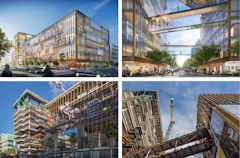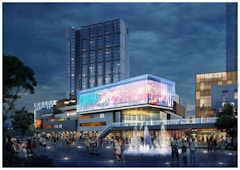
28 results
-
 The structural glass storefront facade at 111 Main Street in Salt Lake City lends itself as a case study in accommodating large building…
The structural glass storefront facade at 111 Main Street in Salt Lake City lends itself as a case study in accommodating large building… -

Breathing Lessons
- Paper by Xaver Nuiding · Thomas Lorenz · Philipp Herreiner, MSc. · Dr.-Ing. Michael Engelmann
For a new corporate headquarters in San Francisco’s Mission Bay district, SHoP Architects designed a semi-conditioned atrium space inside the
-

Kinetic Solar Envelope Design
- Article by Christina Koukelli · Alejandro Prieto · Serdar Asut
Authors Christina Koukelli, Arup, Alejandro Prieto, Diego Portales University, and Serdar Asut, TU Delft, address the potentials of Shape Memory Alloys (SMAs) for the design of autoreactive facade systems without using additional energy.
-

Kinetic Solar Envelope
- Paper by Christina Koukelli, Facade Engineer Alejandro Prieto, Researcher Serdar Asut, Academic, Architect
Kinetic responsive systems are gaining attention in architectural applications, to reduce the building’s energy consumption and environmental impact,… -

Kinetics in Building Facades
- Paper by Sean Cullen · Professor Greg Keeffe
The prominence of climatically responsive building facades through the use of kinetics has proliferated in recent years due to a concern for the
-

Kinetic Shading Systems
- Paper by Alireza Jahanara, Negar Kalantar,
This study focuses on experiments in kinetics and architectural skins. More extensively, it introduces a solution for environmental design issues and… -

Multi-domain Assessment of a Kinetic Facade
- Paper by Kunyo Luo, Master of Building Science Karen Kensek, LEED AP BD+C, DPACSA, Professor of Practice Marc Schiler, FASES, Professor
An assessment workflow was created to simulate and evaluate the performance of a kinetic facade in an interior space. It includes parameters of… -
The Poetry, Pitfalls and Potential of Kinetic Facades
The Poetry, Pitfalls and Potential of Kinetic Facades is an ongoing series published by the Advanced Technology Studio of Enclos examining kinetic components in building envelopes — often eye-catching, occasionally gimmicky, and almost always a technical and economic challenge.
-

Passively Actuated Systems
- Paper by Manuel Benitez Ruiz · David Gerber
Kinetic or responsive facades have been developed to improve buildings' daylighting conditions while mitigating energy consumption. Still, these
-

Heat-actuated Auxetic Facades
- Paper by Amira Abdel-Rahman · Elnaz Tafrihi
Highly transformable materials can be used as adaptive exterior shading systems by leveraging the relationship between external stimuli (heat) and
-

Integrating Soft Robotics into Architectural Assemblies
- Paper by Vera Parlac, Associate Professor
The project described in this paper explores the integration of custom-made soft robotic muscles into a component-based surface. This project is part… -

Facade Tectonics Forum: MINNEAPOLIS
- Event by Facade Tectonics Institute
FTI touched down in Minneapolis to confront themes central to the ever-evolving facade: energy-efficiency and sustainability, digital technology, kinetic and dynamic components, and material evolution.
-
Let Thin Glass in the Facade Move
- Paper by Prof. DI Dr. Jürgen Neugebauer · DI Dr. Markus Wallner-Novak
Facades play an important role in the control of energy flow and energy consumption in buildings as they represent the interface between the outdoor
-
Translation from Concept to Construction
- Paper by Ryan Donaghy, AIA · Matthew Spahr, PE
Fidelity between the built enclosure and early visualizations is rarely, if ever, an accident. When achieved, it comes as the result of persistent
-

Vertical Louvered Solar Control
- Paper by Clifton Fordham, RA, LEED AP,
Exterior shading devices, when typically used, are horizontal planes that are most effective at the south face of buildings in the northern… -
Facing Density
- Paper by Wendy Cox
The United Nations Department of Economic and Social Affairs projects a world population growth of over three billion over our current, nearly eight
-
Recent Adaptive Textile Façade Systems
- Paper by Lucio Blandini, Director, Full Professor Moon-Young Jeong, Doctoral Researcher Michael Voigt, Doctoral Researcher, IKTD, University of Stuttgart Jonathan Lopez, Doctoral Researcher Hannah Schürmann, Doctoral Researcher Arina Cazan, Research Assistant Hannah Raisch, Student Daniel Roth, Head of Research Group Methodical Product Development, IKTD, University of Stuttgart Maria Matheou, Junior Professor
Adaptive facade systems are a promising approach to achieve a dynamic response to varying weather conditions and user demands. The interdisciplinary… -

Predictive Modeling in an Automated Building Facade
- Paper by Troy Nolan Peters PhD, Associate Professor
Computer simulations of an automated dynamic facade in a passively heated and cooled building by using predictive modeling of short-term future… -
Collaborative Methodology for Fastracking Challenging Facade Concepts
- Paper by Stuart Berriman · Peter Simmonds, Ph.D., FASHRAE, FIBPSA, FFTI
The goal is to explore the role and methodology employed between the architect and engineer as they look to resolve the opposing demands of design
-

Exo-Skins
- Paper by Nick Braaksma, Malini Srivastava, AIA, Chad Ulven,
Cost-effective, sustainable, self-actuating, thermally-responsive, bio-composite exo-skins that act like shields or cloaks for existing buildings…


